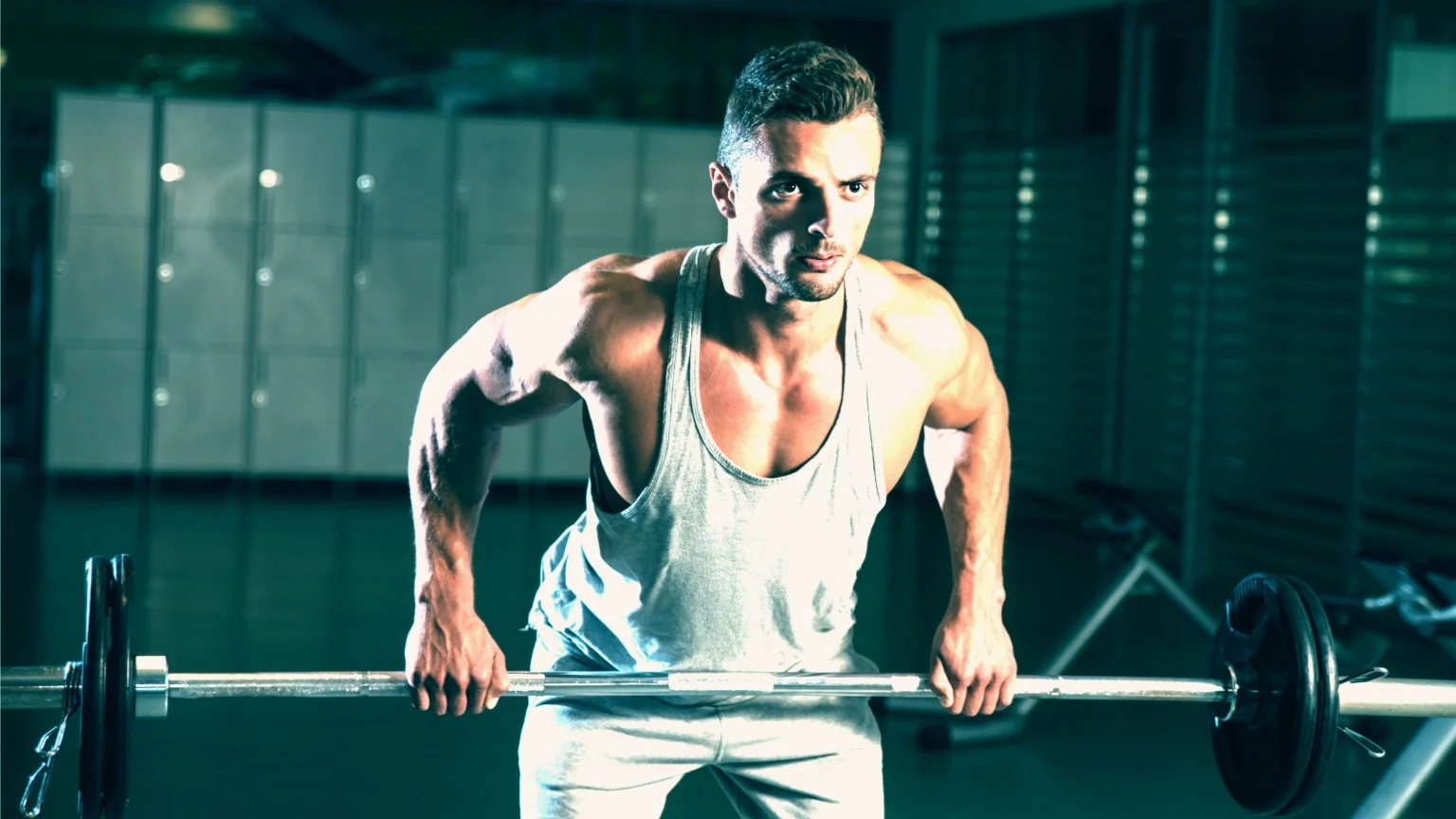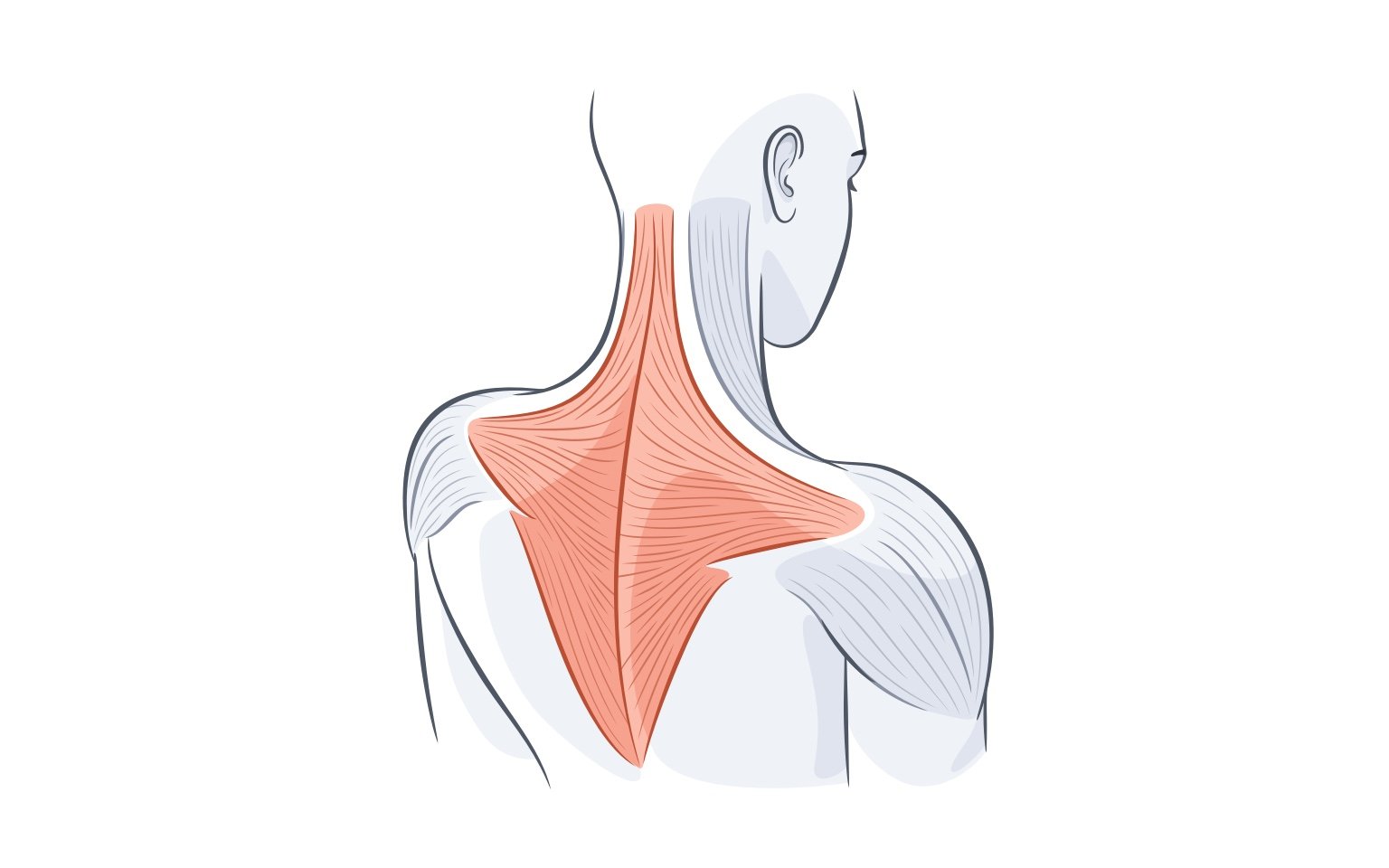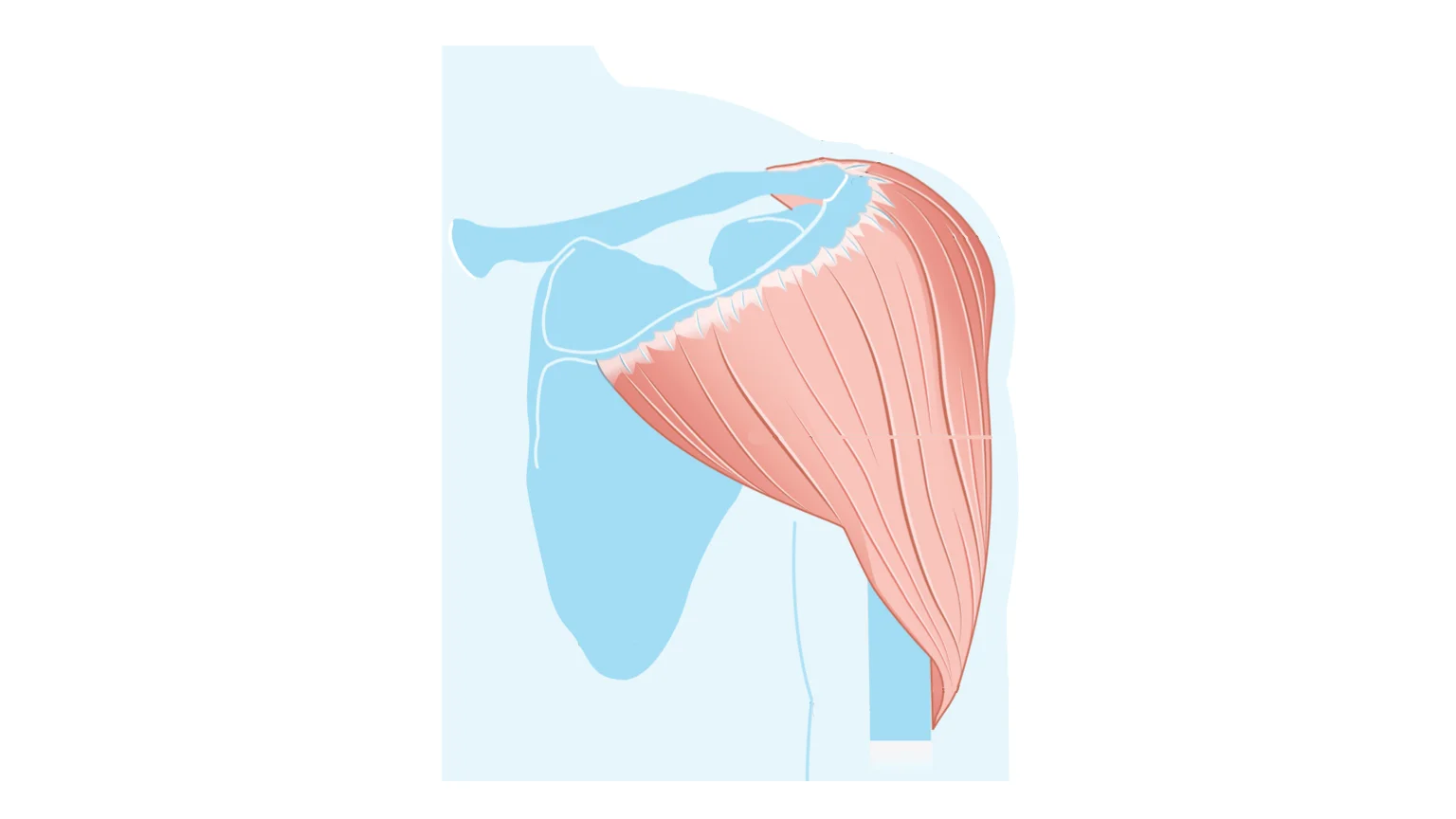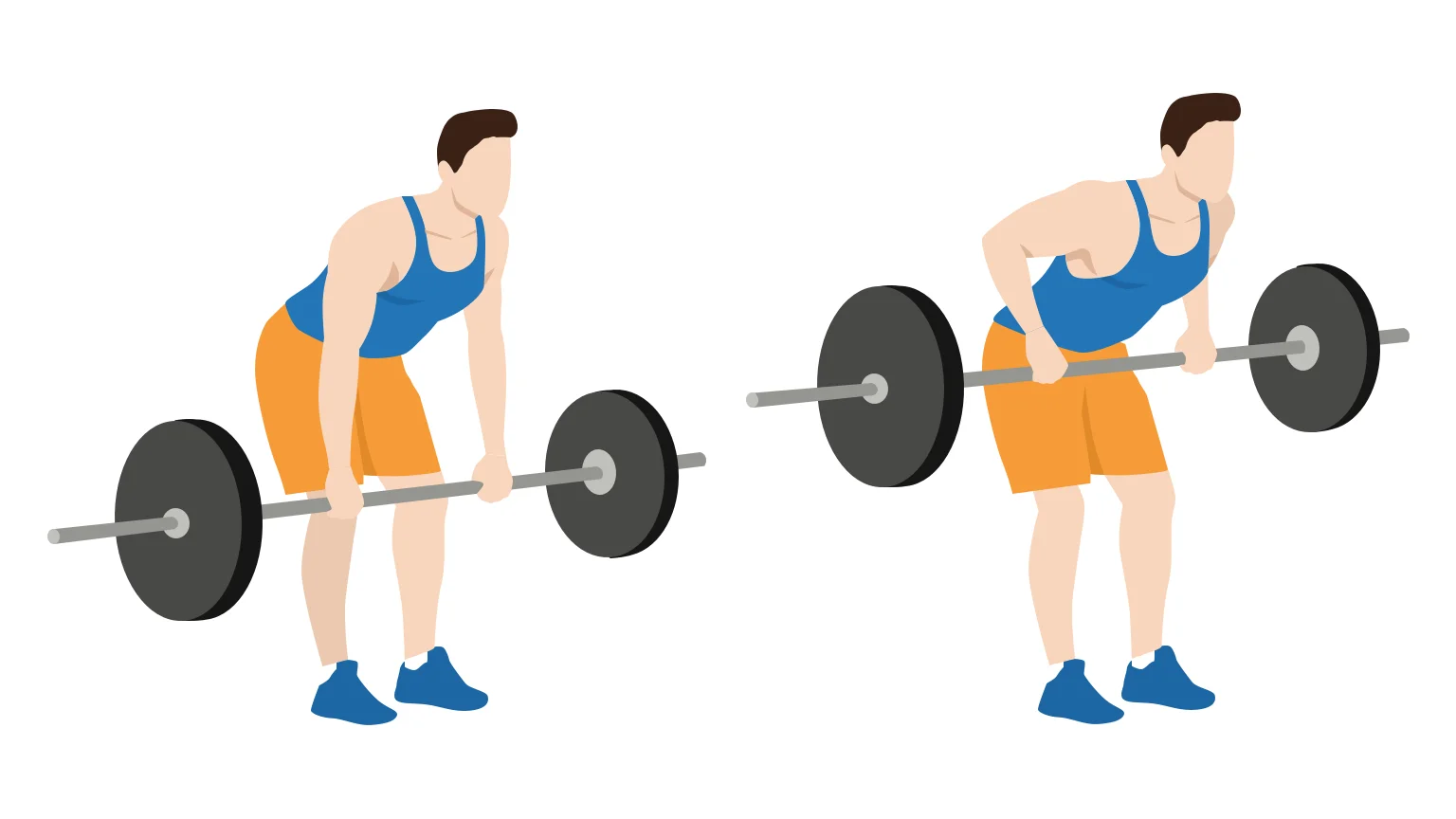Bent Over Row Exercise Guide – 6 Variations

The bent over row is a go-to pull exercise that primarily targets your upper back muscles, particularly your lats, traps and rhomboids. The exercise also works your biceps and forearms as secondary muscles.
It’s worth adding bent over rows to your ‘back day’ or back and biceps routine, because it offers a comprehensive upper back workout. Being a compound exercise that hits multiple muscle groups, including your biceps to some degree, it can make your workout routine more efficient in terms of frequency and volume.
Bent over rows are a good way for beginners to build foundational strength and learn the proper form for many upper back pull exercises. If you are new to lifting, start with lighter weights and gradually increase as your strength improves.
Jump to
- How to do a bent over row
- Variations:
Muscles worked
Lats
The bent over row primarily works your latissimus dorsi (lats) muscles. Your lats are the biggest muscles in your upper body, running along the sides of your middle-to-lower back. They play a key role in pulling moves and help with everyday activities and exercises like swimming and pull ups.

Big and strong lats not only helps with lifting but, being the largest muscle group, they contribute to a well-defined and sculpted back.
With bent over rows, you can achieve a more intense workout of your lats by maintaining a wider grip on the barbell. Learning further forwards can also increase the emphasis on your lats during the rows.
Trapezius
Your trapezius (traps) muscles are the large triangular-shaped muscles that extend all the way over the back of your neck and deltoids, extending right down to the upper middle part of the back. It is divided into three parts called the upper, middle and lower traps. They move your shoulders and assist in moving your arms out to the side. Your middle and lower traps also help to retract and depress your shoulder blades.

Your traps are one of the primary muscle groups worked by bent over rows. Similar to the lats, a wider grip on the barbell will emphasize your traps more than with the standard shoulder-width grip. Squeezing and pausing at the top of the movement can also engage the traps, leading to further strength gains.
Rhomboids
Your rhomboids are the third major upper back muscle worked by bent over rows. The rhomboids are made up of two muscles – the rhomboids major and rhomboids minor. They are both located between your spinal column and your shoulder blades. Strong rhomboids help you maintain good shoulder posture, and help you elevate, retract and rotate your shoulder blades.
Try to keep your shoulders engaged throughout each bent over row. To shift emphasis onto your rhomboids, you can consider using an underhand grip instead of the standard overhand grip.
Rear deltoids
Your rear delts, also known as posterior delts, are located at the back of your shoulders. They assist in pulling back your shoulders. Developing your rear deltoids can help you achieve a balanced and rounded shoulder appearance. Stronger rear deltoids can also help with posture and reduce the risk of shoulder injuries in other exercises.

The bent over row is a great compound exercise that hits your rear delts. You can put more emphasis on your rear delts by bending further forwards. However, this posture will not work your biceps or lats to the same degree.
Secondary muscles
The bent over row primarily works your upper back muscles. But it also works a number of secondary muscle groups, too. This includes your abs, which helps stabilize your body during the rows, and your biceps, which are engaged when you row the weight towards you (the flexion phase of the movement).
Bent over rows also activate your lower back muscles, which helps support your spine and provide balance and stability.
Benefits of bent over rows
Increasing muscle mass
Because they target some of your largest muscle groups simultaneously, bent over rows are a great way to quickly build muscle mass in your upper body.
Resistance training, including bent over rows, is a proven way to build muscle. When you subject your muscles to resistance, you cause microscopic tears in the muscle tissue. Over a period of 48-72 hours, your body responds by repairing the damaged fibers, which results in more muscle mass (i.e. bigger muscles). This process is called muscle protein synthesis.
Developing muscle mass and training the posterior chain is key for powerlifters and Olympic lifters. The muscles along the posterior chain – hamstrings, glutes, lower and upper back – drive strength and power in many lifts.
Back strength
Back strength is important for increasing your pulling power. The bent over row can improve your back strength because it works the largest muscle groups in your back, including your lats, traps and rhomboids.
A strong back helps in other exercises, including deadlifts, squats and bench press. These make up the 3 key powerlifting exercises. Because a strong back encourages you to maintain proper form, other exercises can emphasis their target muscle groups, which can make them more effective.
Overhead lifts also benefit from increased back strength as engagement of your upper back muscles can provide stability while holding weight above your head.
Lower back pain
Bent over rows may help if you suffer from lower back pain. By strengthening the muscles in your lower back and core, this exercise can provide additional support to your lumbar spine. This can improve your overall torso posture and reduce stress on individual muscle groups, helping to address back pain in some people.
However, you may instead find that bent over rows irritate your lower back. If you have a lower back complaint, improper form or lifting too much weight could lead to further injury. You should consult a personal trainer and medical professional if you suffer from lower back pain before engaging in any new exercise.
Improves posture
Because bent over rows strengthen the muscles in your back, shoulders and arms, this can over time improve your overall posture. A strong back also promotes musculoskeletal stability (?) across the spine, which can help prevent injuries and the development of back pain.
How to do a bent over row

- Stand behind the barbell with your feet placed shoulder to hip width apart. Bend slightly at your knees and hips, just enough to allow you to reach the barbell, but do not squat down fully as you would do for a deadlift. Your back should be straight at an approximately 45 degree angle.
- Grab the barbell with an overhand grip, with your hands positioning at slightly more than shoulder-width apart.
- Maintaining a straight back and arms fully extended, drive your elbows back while keeping them close to your body. Aim to pull the barbell towards your belly button.
- As you pull the barbell up, fully contract your back muscles for maximal engagement. Squeeze at the top of the movement and pause for 1 second.
- Reverse the movement, returning the barbell to the starting position.
Sets and reps
The number of sets and reps for bent over rows depends on your workout routine, and whether you goal is to build muscle mass or strength.
If you are aiming to build muscle mass, aim for 3-4 sets of 6-10 reps per set.
If you are instead looking to build strength, then 3-4 sets of 4-6 reps is a good place to start.
For beginners or those just starting with bent over rows, start with 2-3 sets of 8-10 reps using a light weight or even just the barbell itself. It’s important to learn the proper form, then gradually increase the weight as your strength and technique improves.
Tips for bent over rows
- Head position – Maintaining a neutral neck is important to performing bent over rows safely. When performing this exercise, it might be useful to gaze your eyes on a particular spot on the floor 3-4 feet ahead of you.
- Neutral spine – Maintain a neutral spine, both with your neck and lower back in particular. Pushing back your hips can help stabilize your lower back. Advanced lifters may incorporate a slight extension of the back while performing the row, in a variation known as the flexion row. This is an advanced technique that requires excellent form and control, and should be used with caution for most lifters.
- Start with a lighter weight – Lifting heavy weight can result in ‘jerky’ movements, which reduces the effectiveness of the workout and can lead to injuries. Select a weight you can lift in slow, controlled reps. With a suitable weight, it should take you about 3 seconds to lift and another 3 seconds to lower. As you develop the proper form, gradually increase the weight.
Dumbbell bent over row
Why: Both barbell and dumbbell bent over rows target similar muscle groups, but dumbbells allow a greater degree of flexibility and individual arm movement. This makes it a greater option if you have a bilateral muscle imbalance. Dumbbell bent over rows are a great exercise to work your lats, traps and rhomboids, as well as improve control with free weights.
How to do: Stand with your feet hip-width apart, holding a dumbbell in each hand. Your palms should be facing your torso. Bend at your knees and hinge forward at your hips until your torso is almost parallel with the floor. Maintaining a straight back and keeping your elbows close to your body throughout the movement, pull the dumbbells towards your chest. Squeeze your shoulder blades at the top of the movement, then lower the weights back down to the starting position.
Kettlebell bent over row
Why: Because the weight of kettlebells ‘hangs’ below your hands, rather than held directly, the change in weight distribution provides a unique challenge to the bent over row, requiring more control and coordination.
How to do: Stand with your feet hip-width apart and hold a kettlebell in one hand. Bend at your knees and hinge forward at your hips until your torso is almost parallel with the floor. Maintaining a straight back and keeping your elbows close to your body throughout the movement, pull the kettlebell towards your chest. Squeeze your shoulder blades at the top of the movement, then lower the bell back down to the starting position.
One-arm dumbbell bent over row
Why: This variation of bent over rows works one side of your body at a time. This helps you focus on the muscle groups being worked, as well as addressing any strength imbalances you may have.
How to do: Stand with your feet hip-width apart, holding a dumbbell in one hand. Place your other hand on a training bench for support. Bend at your knees and hinge forward at your hips until your torso is almost parallel with the floor. Maintaining a straight back and keeping your elbows close to your body throughout the movement, pull the dumbbell towards your chest. Squeeze your shoulder blades at the top of the movement, then lower the weight back down to the starting position.
Reverse grip bent over row
Why: The reverse grip variation of the bent over row uses an underhand grip instead of an overhand one. This places greater emphasis on your lats and rhomboids.
How to do: Stand behind the barbell with your feet placed shoulder to hip width apart. Bend slightly at your knees and hips. Grab the barbell with an underhand grip, with your hands positioning at slightly more than shoulder-width apart.
Maintaining a straight back and arms fully extended, drive your elbows back while keeping them close to your body. Aim to pull the barbell towards your belly button. Squeeze at the top of the movement, then return the barbell to the starting position.
Landmine T-Bar row
Why: Instead of using a barbell or dumbbells, this variation sees you lift one end of an Olympic bar fixed to the landmine attachment. This allows for a greater range of motion and can also be less stressful on your lower back.
How to do: Place one end of an Olympic bar into the landmine attachment. Stand over the bar with your feet shoulder-width apart. Bend at your hips and knees and grab the end of the bar with both hands. Keeping your back straight, pull the bar up towards you, driving your elbows up and back. Squeeze at the top of the movement, then slowly lower back to the starting position.
References
Schoenfeld, B. J., Ogborn, D., & Krieger, J. W. (2016). Effects of resistance training frequency on measures of muscle hypertrophy: a systematic review and meta-analysis. Sports medicine, 46(11), 1689-1697.
MacDougall, J. D., Gibala, M. J., Tarnopolsky, M. A., MacDonald, J. R., Interisano, S. A., & Yarasheski, K. E. (1995). The time course for elevated muscle protein synthesis following heavy resistance exercise. Canadian Journal of applied physiology, 20(4), 480-486.
